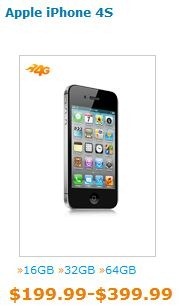Trouble in Nerdville! Thanks to Apple’s most recent software update, some AT&T iPhone 4S owners are now noticing new “4G” icons where the “3G” icons on their handsets once lived. So does that mean the iPhone 4S has a 4G connection now?
 No.
No.
And “no” in two ways. Either it doesn’t have a 4G connection at all or it doesn’t have a 4G connection now, since it’s always had one.
There’s some marketing at play here but whatever the case, your phone’s connection speed is no faster today than it was last week.
AT&T has touted the iPhone 4S as a 4G-capable phone since it first went on sale (notice the “4G” icon in the image on the right), but only with Apple’s most recent software update has AT&T been able to display a 4G icon next to the phone’s connection status.
The Verge’s Nilay Patel refers to this as “a triumph of marketing,” and laces his post with various tweets from people saying things like “I have 4G on my iPhone now?! #hellyeah”. That type of consumer confusion is really the biggest problem here.
Owners of the [AT&T] iPhone will notice no difference in performance or data transfer speeds; the device will not magically connect to AT&T’s shiny new 4G LTE network. It will simply receive a deceptive labeling change that allows AT&T to market the iPhone as a 4G device against competitive phones from Verizon — including, perhaps most importantly, Verizon’s own 3G iPhone 4S. It is a triumph of marketing for AT&T, and a rare acquiescence to a poor and confusing user experience for Apple.
AT&T’s spokesperson responded that the use of the 4G icon is “essentially the same as many other current AT&T smartphones,” which is true. The issue is that the definition of a “4G” cellular connection has basically become “anything that’s faster than 3G” here in the U.S.
We actually fielded this question when the iPhone 4S first came out: Is the iPhone 4S a 4G phone on AT&T and a 3G phone on Verizon? Here’s a snippet of the answer:
As far as smartphones go, here’s a basic overview of the various connection options in order from slowest to fastest:
3G < WiMAX (Sprint) < HSPA+ (AT&T/T-Mobile) < 4G LTE(Verizon/AT&T)
For simplicity’s sake, we’ll consider 4G speeds to be anything other than 3G even though the post-3G technology is sometimes referred to as 3.5G. And 4G in the U.S. isn’t true 4Gas far as worldwide standards go, but the masters of marketing at Sprint, Verizon, AT&T and T-Mobile have squeezed the 4G toothpaste out of the tube by referring to 4G in the sense that the devices use “fourth-generation” networks here, so let’s just go with it.
The four major carriers use different flavors of 4G, which is where a lot of the confusion comes from. In their defense, any “4G” device can theoretically pull in wireless data a lot faster than 3G devices, regardless of the flavor. Sprint uses “WiMAX”, T-Mobile uses “HSPA+”, Verizon uses “LTE” and AT&T uses both HSPA+ and LTE, depending on the device. LTE is the next big thing, so if you’re really concerned about speed and you want to future-proof yourself, look for an LTE smartphone…
…So, short answer (too late), under optimal conditions the iPhone 4S on AT&T is theoretically faster at downloading and uploading data than the Verizon (and Sprint) versions. But as far as the world standards for 4G networks—as set by the International Telecommunications Union—go, none of the networks in the U.S. qualify as delivering actual 4G speeds.
*Sigh* – it’s complicated, right? The basic thing, though, is that the new 4G icon on your AT&T iPhone 4S hasn’t actually done anything different to your phone. It’s been offered as a “4G” phone at AT&T since day one due to how AT&T and T-Mobile define their HSPA+ networks.
MORE: Ask Techland: What’s the Deal with 4G? Is the New iPhone 4G?

